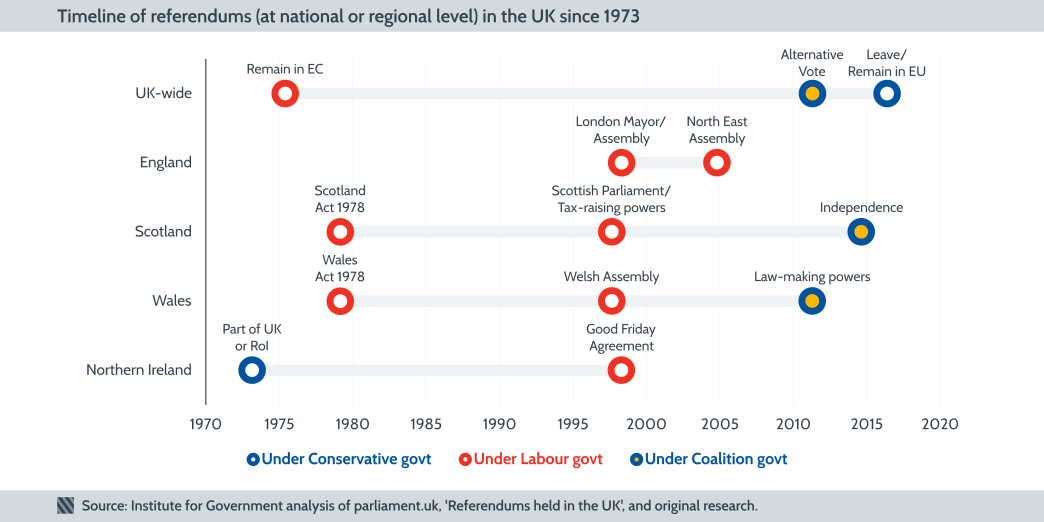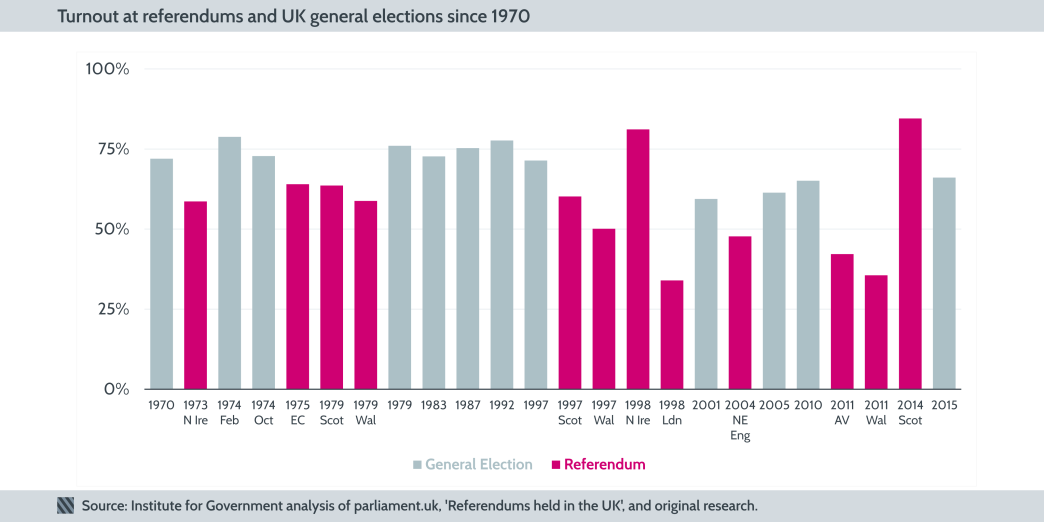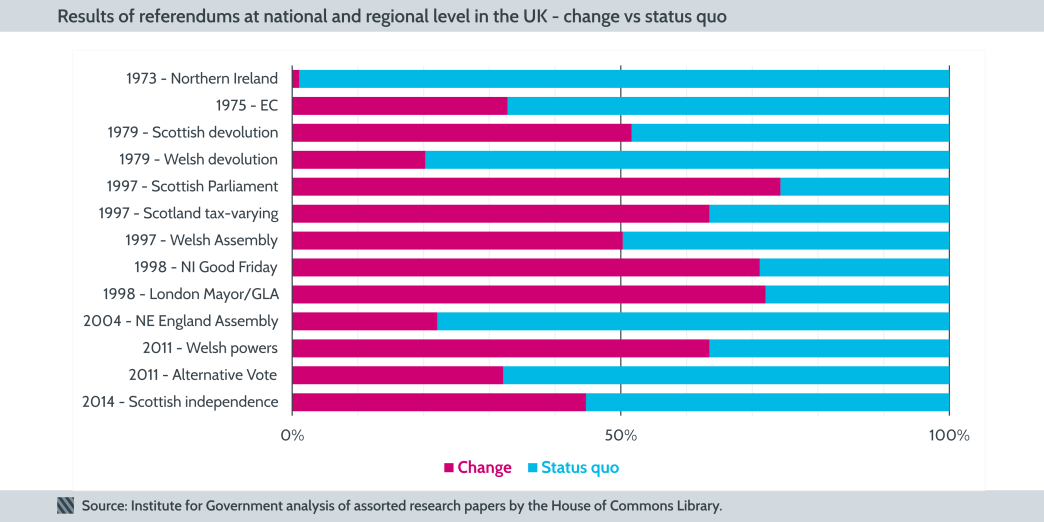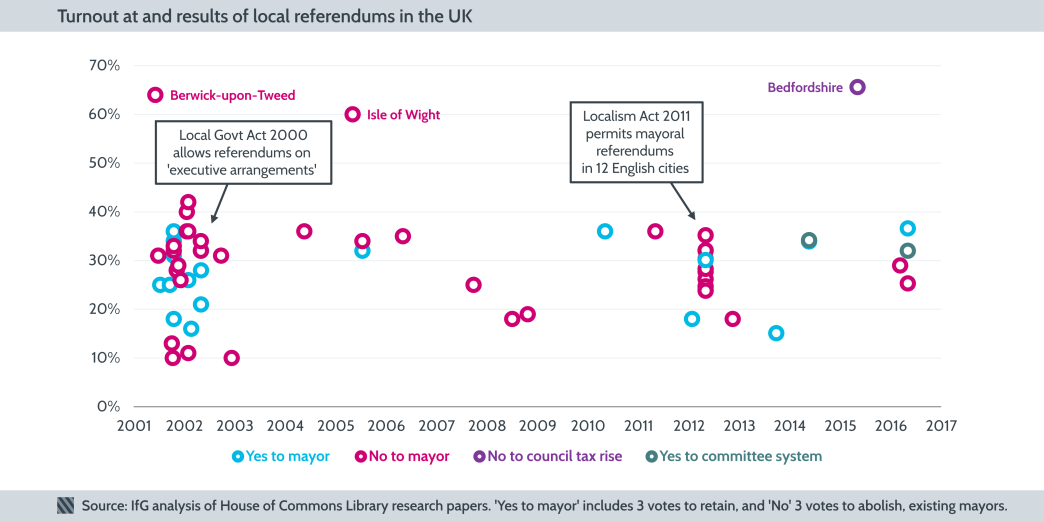Never mind the ballots: referendums in the UK
With the European Union (EU) referendum due to be held this Thursday, 23 June, Leah Owen and Gavin Freeguard look at the history of referendums in the UK in four charts.
The EU referendum will be the third UK-wide referendum in British political history.
As our colleague Akash Paun notes, referendums have tended to be used ‘to settle questions of an indisputably constitutional character’. Thursday’s vote is the second UK-wide referendum on Europe – in 1975, the question put to voters was ‘Do you think the UK should stay in the European Community (Common Market)?’ The only other UK-wide referendum was on whether to adopt the Alternative Vote system for parliamentary elections.
There have been:
- three referendums each in Scotland (two on devolution – although the 1997 one included two questions – and one on independence) and Wales (all on devolution)
- two in Northern Ireland – whether to remain part of the UK or join with the Republic of Ireland in 1973, and on the Good Friday Agreement in 1998
- two referendums on questions of English devolution at a regional level – on a London Mayor and Assembly in 1998 and a devolved assembly for the North East of England in 2004. (We have more on local referendums below.)
Referendums have come in clusters: the first in the 1970s (under Conservative and Labour governments), then in the late 1990s under New Labour, and then since 2010. Thursday’s referendum is the second to be held by a Conservative government.
Turnouts at referendums tend to be lower than in general elections.
Only two referendums have had higher turnouts than recent general elections: on the Good Friday agreement in Northern Ireland in 1998 (81.1%) and on Scottish independence in 2014 (84.6%).
Turnout in Northern Ireland in 1973 (58.7%) was depressed by a boycott – less than 1% of the Roman Catholic population were said to have voted.
The change option has beaten the status quo in seven of the thirteen referendum questions to date.
Interestingly, despite the ‘status quo bias’ observed in referendums internationally, in the UK the ‘change’ option has been preferred seven times and the ‘status quo’ option six times. In 1979, 51.6% voted in favour of Scottish devolution – but this did not meet a required turnout threshold, so no Scottish Assembly was introduced.
Although referendums at national and regional level attract most political and media attention, there have been 61 referendums at local level since 2001.
Local referendums can be held under two different pieces of legislation:
- The Local Government Act 2000 allows councils and citizens to trigger votes on councils’ executive arrangements (usually to introduce a mayor).
- The Localism Act 2011 fulfilled a Conservative manifesto pledge to allow mayoral referendums in England’s 12 largest cities. It also means that councils wanting to increase their council tax by a certain amount have to hold a referendum.
To date:
- 16 areas have voted to introduce a mayor, and 36 have voted against (the status quo bias appears alive and well). Guildford will vote on a mayor in October 2016.
- Three areas have voted to retain a mayor, and three to abolish.
- Two areas (Fylde in May 2014, West Dorset in May 2016) voted in favour of introducing a committee system.
- Only Bedfordshire has held a referendum on a council tax rise (which was rejected).
To date, only the Bedfordshire council tax referendum and the mayoral referendums in Berwick-upon-Tweed in 2001 and the Isle of Wight in 2005, have had turnouts of more than 50%.
Many will agree that Thursday’s referendum will be one of the most important of a generation. We’ll see how that measures up against the referendums of the past.
Data from House of Commons Library briefings on individual referendums and referendums on directly-elected mayors and council tax, and research based on a briefing on referendums held in the UK. See also briefing on Local government: polls and referendums.
Read Akash Paun's blog – The referendum and the British constitution: strange bedfellows?
- Topic
- Ministers



